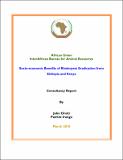Socio-economic Benefits of Rinderpest Eradication from Ethiopia and Kenya
| dc.contributor.author | African Union Inter-African Bureau for Animal Resources | |
| dc.contributor.author | Omiti, John | |
| dc.contributor.author | Irungu, Patrick | |
| dc.contributor.author | AU-IBAR | |
| dc.coverage.spatial | ETHIOPIA | en |
| dc.coverage.spatial | KENYA | en |
| dc.date.accessioned | 2021-06-28T19:04:22Z | |
| dc.date.available | 2021-06-28T19:04:22Z | |
| dc.date.issued | 2010-03 | |
| dc.identifier.uri | http://repository.au-ibar.org/handle/123456789/600 | |
| dc.description.abstract | This study sought to evaluate the costs and benefits of rinderpest eradication from Ethiopia and Kenya. The study used primary data collected through interviews with key informants in Ethiopia and Kenya. Secondary data were also used. In particular, FAOSTAT (2010) cattle population data were used due to lack of consistent country level series covering the study period (1968-2008). Due to the aggregated nature of FAOSTAT data, it was imperative to make assumptions on the data to facilitate the computation of benefits of rinderpest eradication. As far as possible such assumptions were backed up by relevant literature. The costs and benefits of rinderpest eradication were evaluated under a social cost-benefit framework. | en |
| dc.format.extent | 88 pages | en |
| dc.publisher | AU-IBAR | en |
| dc.subject | Rinderpest | en |
| dc.title | Socio-economic Benefits of Rinderpest Eradication from Ethiopia and Kenya | en |
| dc.type | Report | en |
| dc.type | Research Paper | en |
